warning HYUNDAI ELANTRA HYBRID 2021 User Guide
[x] Cancel search | Manufacturer: HYUNDAI, Model Year: 2021, Model line: ELANTRA HYBRID, Model: HYUNDAI ELANTRA HYBRID 2021Pages: 555, PDF Size: 56.08 MB
Page 26 of 555
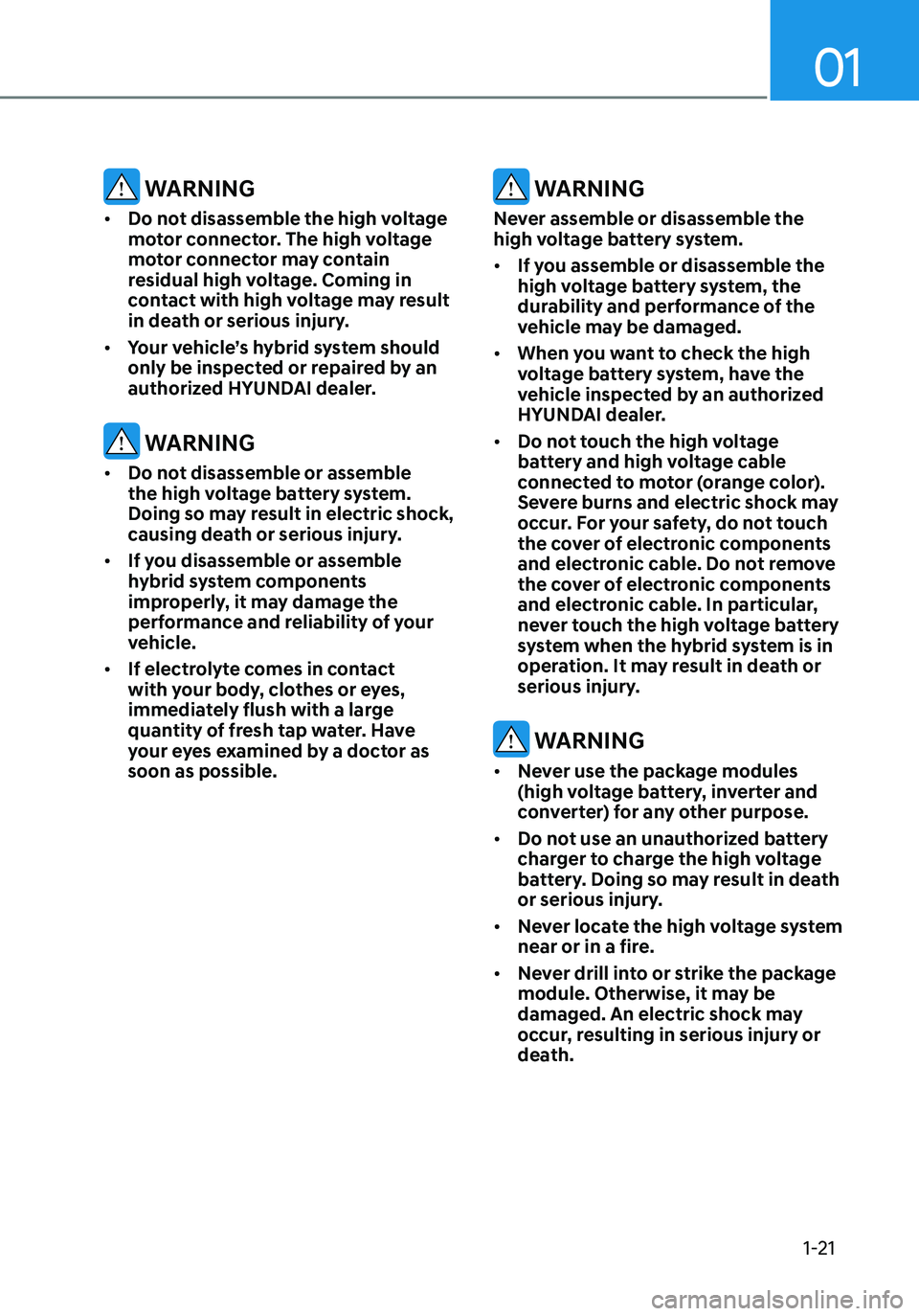
01
1-21
WARNING
• Do not disassemble the high voltage
motor connector. The high voltage
motor connector may contain
residual high voltage. Coming in
contact with high voltage may result
in death or serious injury.
• Your vehicle’s hybrid system should
only be inspected or repaired by an
authorized HYUNDAI dealer.
WARNING
• Do not disassemble or assemble
the high voltage battery system.
Doing so may result in electric shock,
causing death or serious injury.
• If you disassemble or assemble
hybrid system components
improperly, it may damage the
performance and reliability of your
vehicle.
• If electrolyte comes in contact
with your body, clothes or eyes,
immediately flush with a large
quantity of fresh tap water. Have
your eyes examined by a doctor as
soon as possible.
WARNING
Never assemble or disassemble the
high voltage battery system.
• If you assemble or disassemble the
high voltage battery system, the
durability and performance of the
vehicle may be damaged.
• When you want to check the high
voltage battery system, have the
vehicle inspected by an authorized
HYUNDAI dealer.
• Do not touch the high voltage
battery and high voltage cable
connected to motor (orange color).
Severe burns and electric shock may
occur. For your safety, do not touch
the cover of electronic components
and electronic cable. Do not remove
the cover of electronic components
and electronic cable. In particular,
never touch the high voltage battery
system when the hybrid system is in
operation. It may result in death or
serious injury.
WARNING
• Never use the package modules
(high voltage battery, inverter and
converter) for any other purpose.
• Do not use an unauthorized battery
charger to charge the high voltage
battery. Doing so may result in death
or serious injury.
• Never locate the high voltage system
near or in a fire.
• Never drill into or strike the package
module. Otherwise, it may be
damaged. An electric shock may
occur, resulting in serious injury or
death.
Page 27 of 555
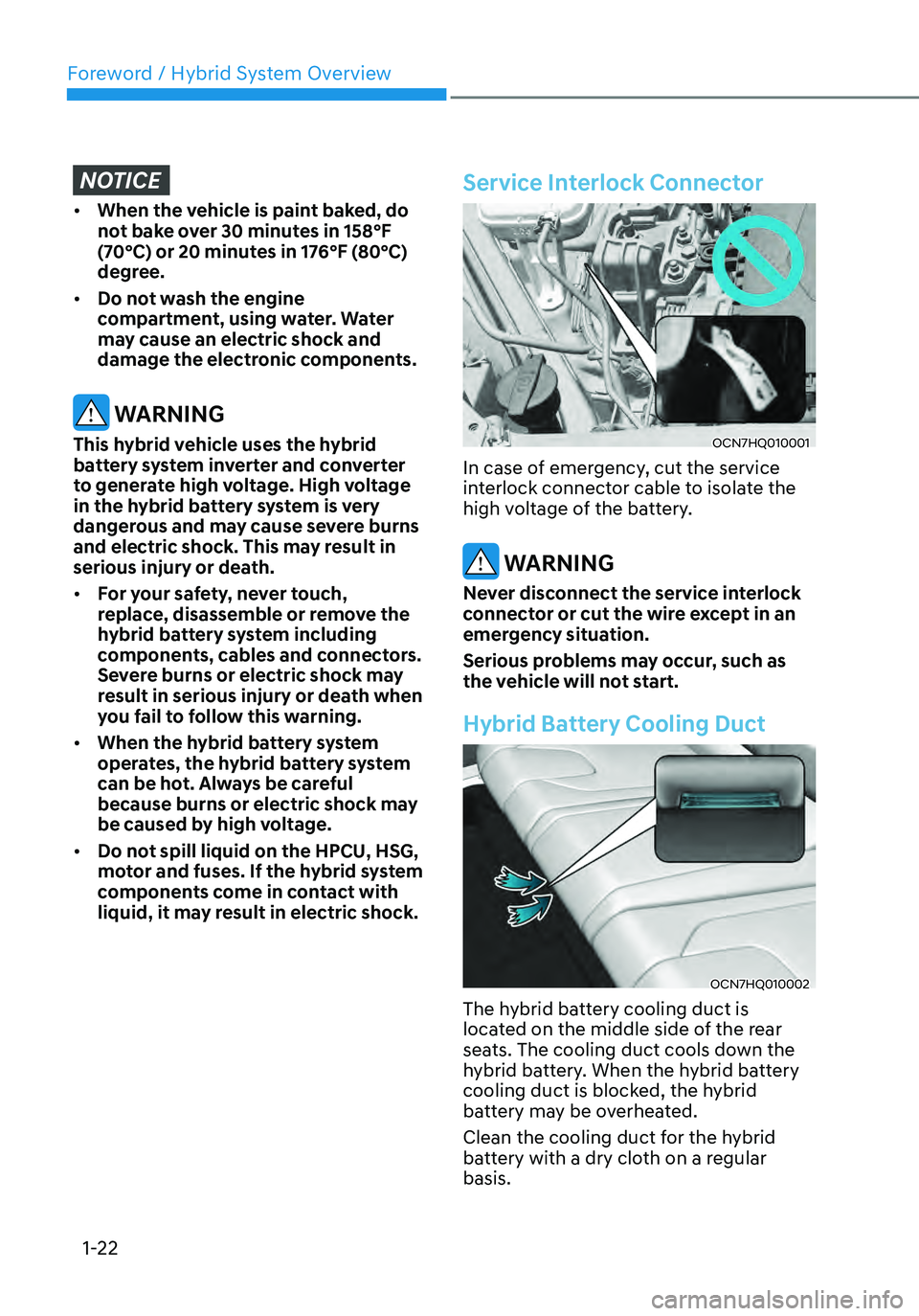
Foreword / Hybrid System Overview
1-22
NOTICE
• When the vehicle is paint baked, do
not bake over 30 minutes in 158°F
(70°C) or 20 minutes in 176°F (80°C)
degree.
• Do not wash the engine
compartment, using water. Water
may cause an electric shock and
damage the electronic components.
WARNING
This hybrid vehicle uses the hybrid
battery system inverter and converter
to generate high voltage. High voltage
in the hybrid battery system is very
dangerous and may cause severe burns
and electric shock. This may result in
serious injury or death.
• For your safety, never touch,
replace, disassemble or remove the
hybrid battery system including
components, cables and connectors.
Severe burns or electric shock may
result in serious injury or death when
you fail to follow this warning.
• When the hybrid battery system
operates, the hybrid battery system
can be hot. Always be careful
because burns or electric shock may
be caused by high voltage.
• Do not spill liquid on the HPCU, HSG,
motor and fuses. If the hybrid system
components come in contact with
liquid, it may result in electric shock.
Service Interlock Connector
OCN7HQ010001
In case of emergency, cut the service
interlock connector cable to isolate the
high voltage of the battery.
WARNING
Never disconnect the service interlock
connector or cut the wire except in an
emergency situation.
Serious problems may occur, such as
the vehicle will not start.
Hybrid Battery Cooling Duct
OCN7HQ010002
The hybrid battery cooling duct is
located on the middle side of the rear
seats. The cooling duct cools down the
hybrid battery. When the hybrid battery
cooling duct is blocked, the hybrid
battery may be overheated.
Clean the cooling duct for the hybrid
battery with a dry cloth on a regular
basis.
Page 28 of 555
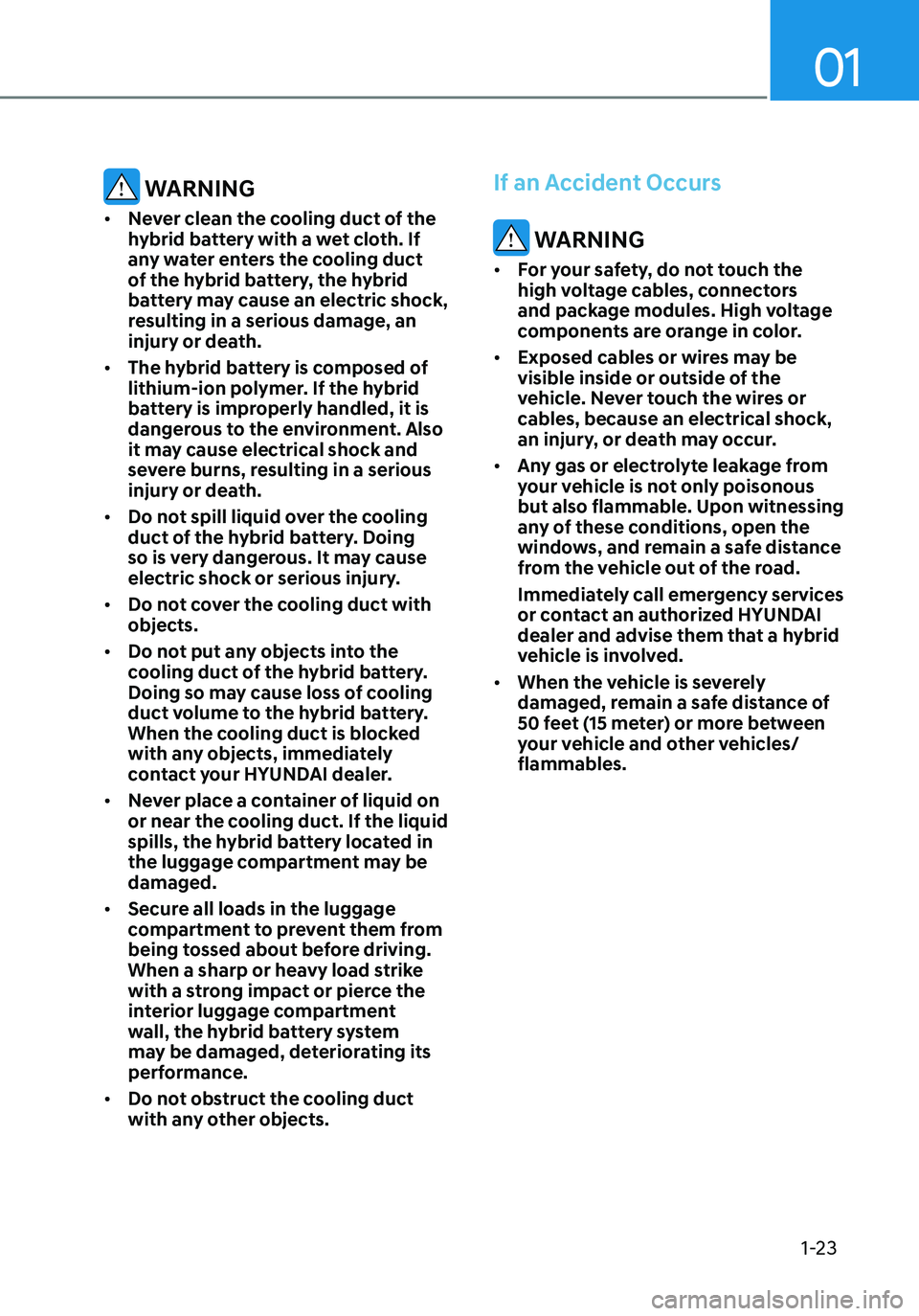
01
1-23
WARNING
• Never clean the cooling duct of the
hybrid battery with a wet cloth. If
any water enters the cooling duct
of the hybrid battery, the hybrid
battery may cause an electric shock,
resulting in a serious damage, an
injury or death.
• The hybrid battery is composed of
lithium-ion polymer. If the hybrid
battery is improperly handled, it is
dangerous to the environment. Also
it may cause electrical shock and
severe burns, resulting in a serious
injury or death.
• Do not spill liquid over the cooling
duct of the hybrid battery. Doing
so is very dangerous. It may cause
electric shock or serious injury.
• Do not cover the cooling duct with
objects.
• Do not put any objects into the
cooling duct of the hybrid battery.
Doing so may cause loss of cooling
duct volume to the hybrid battery.
When the cooling duct is blocked
with any objects, immediately
contact your HYUNDAI dealer.
• Never place a container of liquid on
or near the cooling duct. If the liquid
spills, the hybrid battery located in
the luggage compartment may be
damaged.
• Secure all loads in the luggage
compartment to prevent them from
being tossed about before driving.
When a sharp or heavy load strike
with a strong impact or pierce the
interior luggage compartment
wall, the hybrid battery system
may be damaged, deteriorating its
performance.
• Do not obstruct the cooling duct
with any other objects.
If an Accident Occurs
WARNING
• For your safety, do not touch the
high voltage cables, connectors
and package modules. High voltage
components are orange in color.
• Exposed cables or wires may be
visible inside or outside of the
vehicle. Never touch the wires or
cables, because an electrical shock,
an injury, or death may occur.
• Any gas or electrolyte leakage from
your vehicle is not only poisonous
but also flammable. Upon witnessing
any of these conditions, open the
windows, and remain a safe distance
from the vehicle out of the road.
Immediately call emergency services
or contact an authorized HYUNDAI
dealer and advise them that a hybrid
vehicle is involved.
• When the vehicle is severely
damaged, remain a safe distance of
50 feet (15 meter) or more between
your vehicle and other vehicles/
flammables.
Page 29 of 555
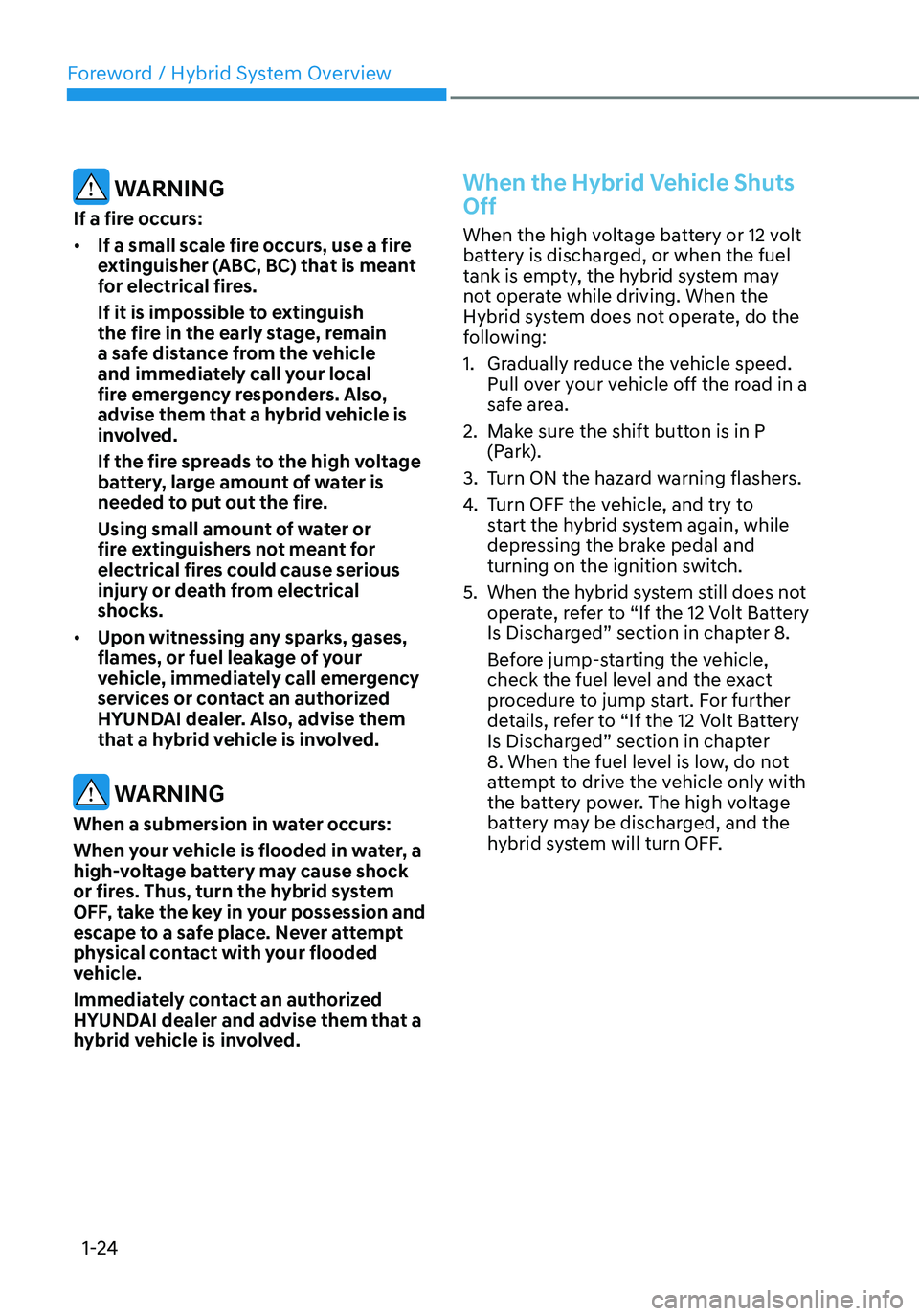
Foreword / Hybrid System Overview
1-24
WARNING
If a fire occurs:
• If a small scale fire occurs, use a fire
extinguisher (ABC, BC) that is meant
for electrical fires.
If it is impossible to extinguish
the fire in the early stage, remain
a safe distance from the vehicle
and immediately call your local
fire emergency responders. Also,
advise them that a hybrid vehicle is
involved.
If the fire spreads to the high voltage
battery, large amount of water is
needed to put out the fire.
Using small amount of water or
fire extinguishers not meant for
electrical fires could cause serious
injury or death from electrical
shocks.
• Upon witnessing any sparks, gases,
flames, or fuel leakage of your
vehicle, immediately call emergency
services or contact an authorized
HYUNDAI dealer. Also, advise them
that a hybrid vehicle is involved.
WARNING
When a submersion in water occurs:
When your vehicle is flooded in water, a
high-voltage battery may cause shock
or fires. Thus, turn the hybrid system
OFF, take the key in your possession and
escape to a safe place. Never attempt
physical contact with your flooded
vehicle.
Immediately contact an authorized
HYUNDAI dealer and advise them that a
hybrid vehicle is involved.
When the Hybrid Vehicle Shuts
Off
When the high voltage battery or 12 volt
battery is discharged, or when the fuel
tank is empty, the hybrid system may
not operate while driving. When the
Hybrid system does not operate, do the
following:
1. Gradually reduce the vehicle speed.
Pull over your vehicle off the road in a
safe area.
2. Make sure the shift button is in P
(Park).
3. Turn ON the hazard warning flashers.
4. Turn OFF the vehicle, and try to
start the hybrid system again, while
depressing the brake pedal and
turning on the ignition switch.
5. When the hybrid system still does not
operate, refer to “If the 12 Volt Battery
Is Discharged” section in chapter 8.
Before jump-starting the vehicle,
check the fuel level and the exact
procedure to jump start. For further
details, refer to “If the 12 Volt Battery
Is Discharged” section in chapter
8. When the fuel level is low, do not
attempt to drive the vehicle only with
the battery power. The high voltage
battery may be discharged, and the
hybrid system will turn OFF.
Page 34 of 555
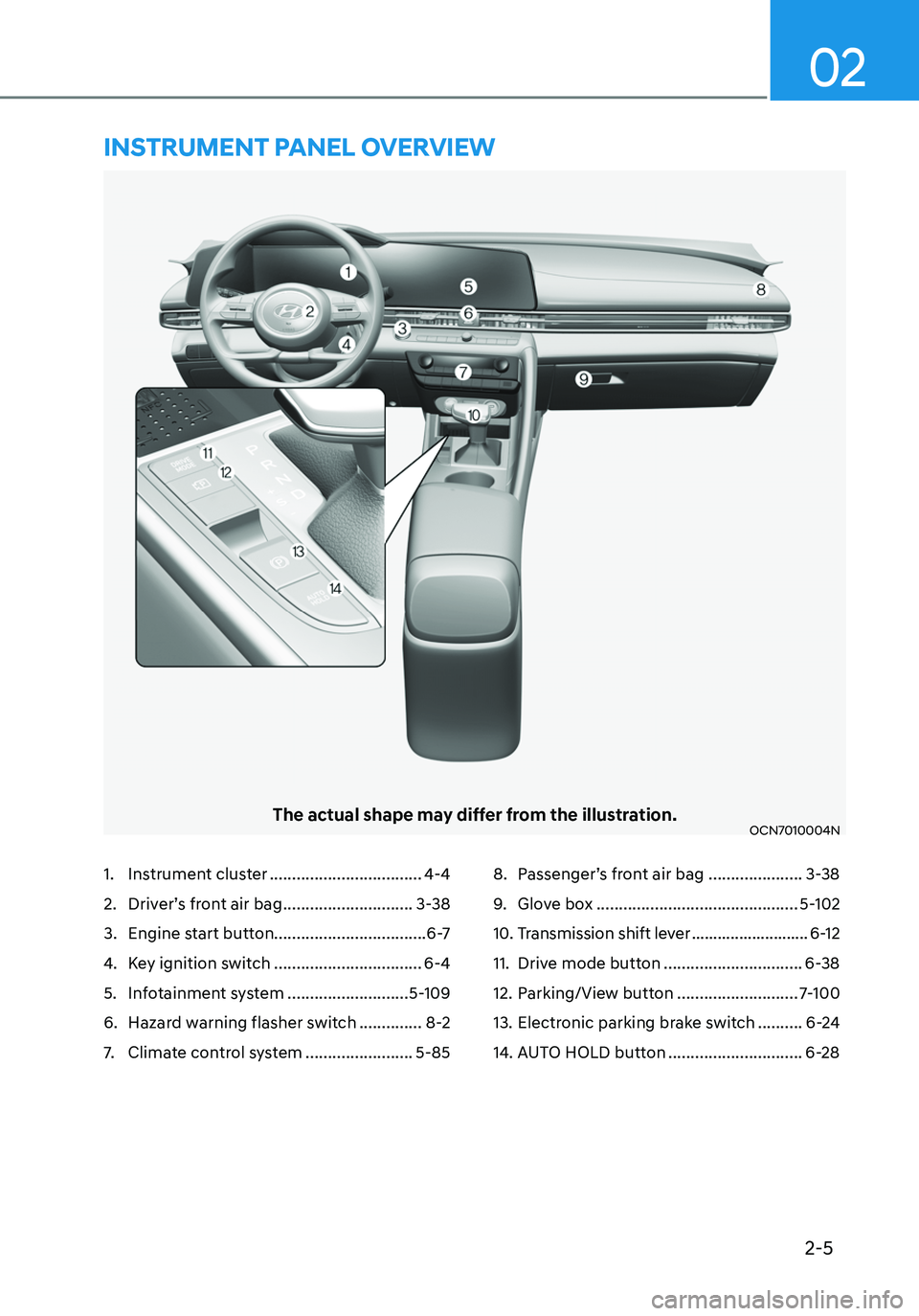
2-5
02
The actual shape may differ from the illustration.OCN7010004N
INSTRUMENT PANEL OVERVIEW
1. Instrument cluster ..................................4-4
2. Driver’s front air bag .............................3-38
3. Engine start button.................................. 6-7
4. Key ignition switch .................................6-4
5. Infotainment system ...........................5-109
6. Hazard warning flasher switch ..............8-2
7. Climate control system ........................5-85
8. Passenger’s front air bag .....................3-38
9. Glove box .............................................5-102
10. Transmission shift lever ...........................6-12
11. Drive mode button ...............................6-38
12. Parking/View button ...........................7-100
13. Electronic parking brake switch ..........6-24
14. AUTO HOLD button ..............................6-28
Page 44 of 555
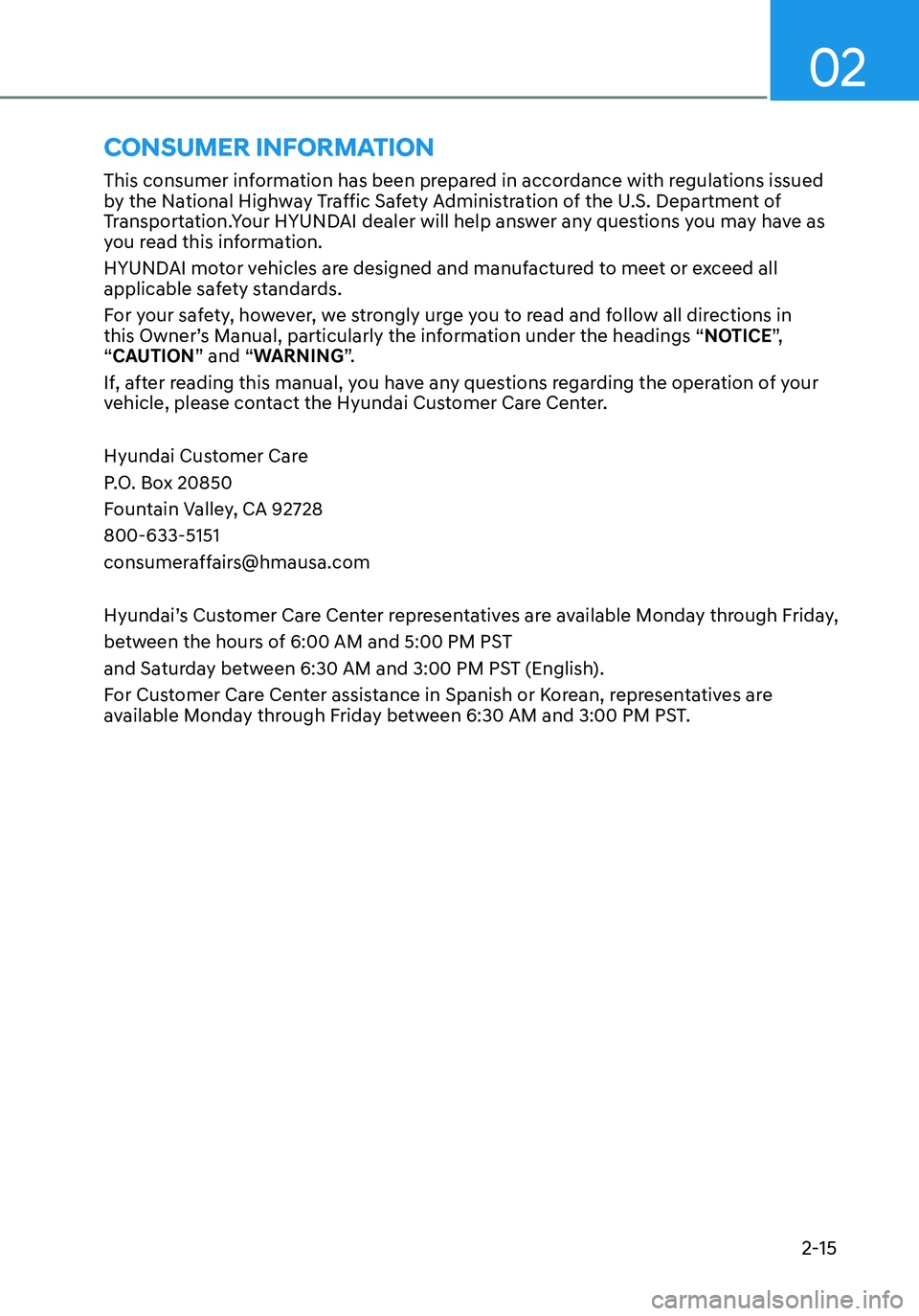
02
2-15
CONSUMER INFORMATION
This consumer information has been prepared in accordance with regulations issued
by the National Highway Traffic Safety Administration of the U.S. Department of
Transportation.Your HYUNDAI dealer will help answer any questions you may have as
you read this information.
HYUNDAI motor vehicles are designed and manufactured to meet or exceed all
applicable safety standards.
For your safety, however, we strongly urge you to read and follow all directions in
this Owner’s Manual, particularly the information under the headings “NOTICE”,
“CAUTION” and “WARNING”.
If, after reading this manual, you have any questions regarding the operation of your
vehicle, please contact the Hyundai Customer Care Center.
Hyundai Customer Care
P.O. Box 20850
Fountain Valley, CA 92728
800-633-5151
[email protected]
Hyundai’s Customer Care Center representatives are available Monday through Friday,
between the hours of 6:00 AM and 5:00 PM PST
and Saturday between 6:30 AM and 3:00 PM PST (English).
For Customer Care Center assistance in Spanish or Korean, representatives are
available Monday through Friday between 6:30 AM and 3:00 PM PST.
Page 46 of 555
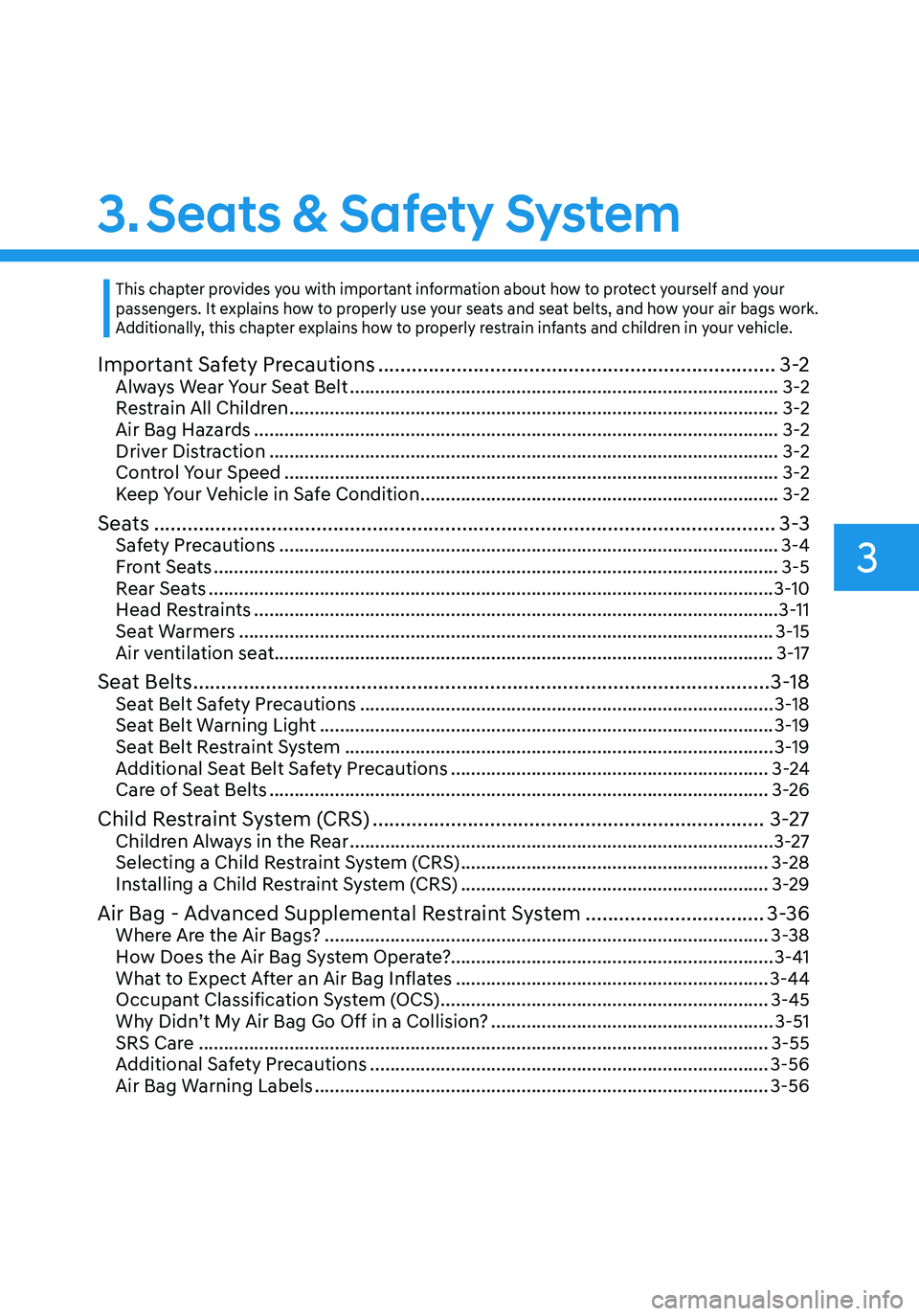
Safety System
3.Seats & Safety System
3
Important Safety Precautions .......................................................................3-2Always Wear Your Seat Belt ........................................................................\
.............3-2
Restrain All Children ........................................................................\
.........................3-2
Air Bag Hazards ........................................................................\
................................3-2
Driver Distraction ........................................................................\
.............................3-2
Control Your Speed ........................................................................\
..........................3-2
Keep Your Vehicle in Safe Condition .......................................................................3-2
Seats ........................................................................\
.......................................3-3Safety Precautions ........................................................................\
...........................3-4
Front Seats ........................................................................\
........................................3-5
Rear Seats ........................................................................\
........................................3-10
Head Restraints ........................................................................\
................................3-11
Seat Warmers ........................................................................\
..................................3-15
Air ventilation seat ........................................................................\
........................... 3-17
Seat Belts ........................................................................\
...............................3-18Seat Belt Safety Precautions ........................................................................\
..........3-18
Seat Belt Warning Light ........................................................................\
..................3-19
Seat Belt Restraint System ........................................................................\
.............3-19
Additional Seat Belt Safety Precautions ...............................................................3-24
Care of Seat Belts ........................................................................\
...........................3-26
Child Restraint System (CRS) ......................................................................3-27Children Always in the Rear ........................................................................\
............3-27
Selecting a Child Restraint System (CRS) .............................................................3-28
Installing a Child Restraint System (CRS) .............................................................3-29
Air Bag - Advanced Supplemental Restraint System ................................3-36Where Are the Air Bags? ........................................................................\
................3-38
How Does the Air Bag System Operate? ................................................................3-41
What to Expect After an Air Bag Inflates ..............................................................3-44
Occupant Classification System (OCS) .................................................................3-45
Why Didn’t My Air Bag Go Off in a Collision? ........................................................3-51
SRS Care
........................................................................\
.........................................3-55
Additional Safety Precautions ........................................................................\
.......3-56
Air Bag Warning Labels ........................................................................\
..................3-56
This chapter provides you with important information about how to protect yourself and your passengers. It explains how to properly use your seats and seat belts, and how your air bags work.
Additionally, this chapter explains how to properly restrain infants and children in your vehicle.
Page 47 of 555
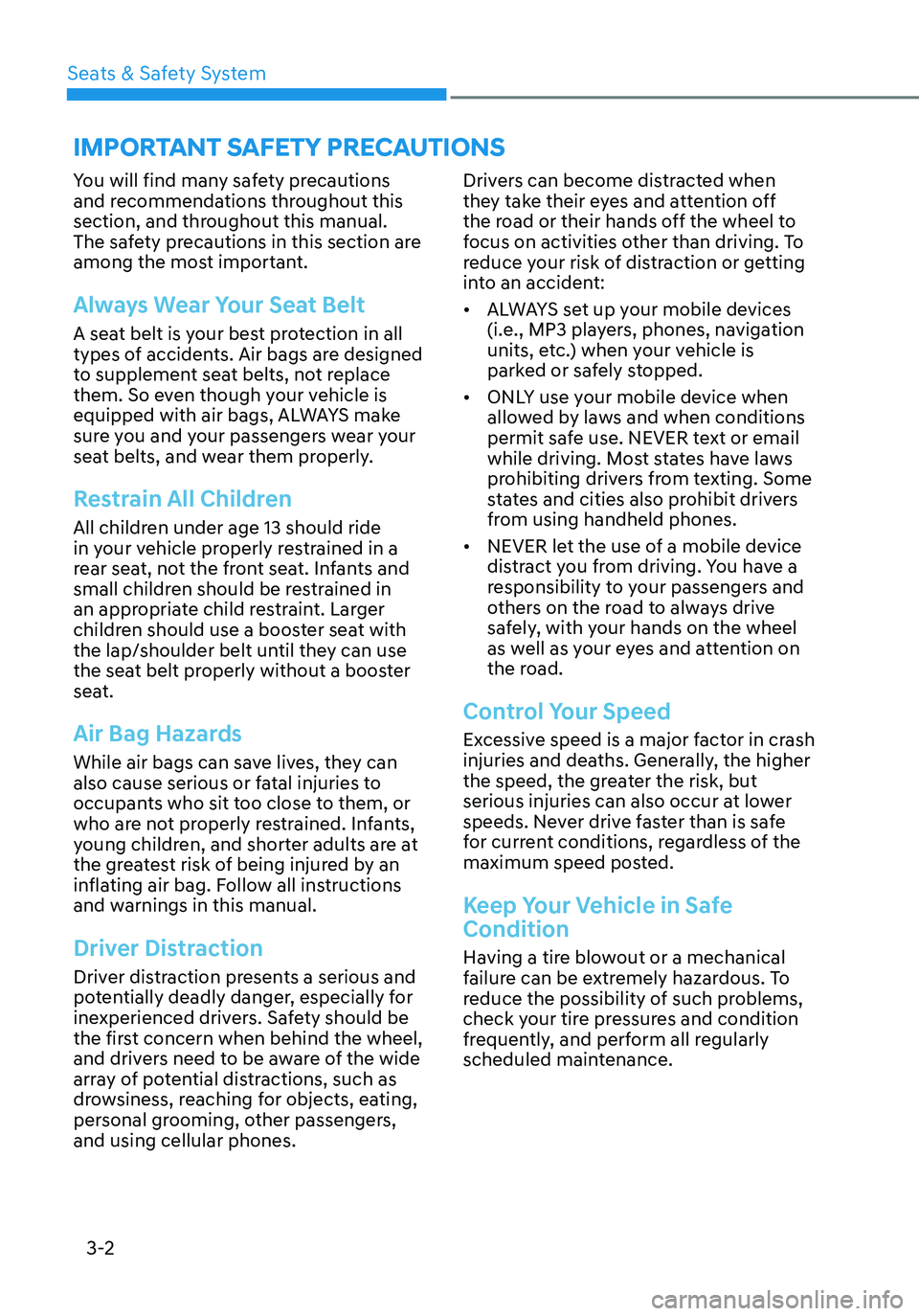
3-2
You will find many safety precautions
and recommendations throughout this
section, and throughout this manual.
The safety precautions in this section are
among the most important.
Always Wear Your Seat Belt
A seat belt is your best protection in all
types of accidents. Air bags are designed
to supplement seat belts, not replace
them. So even though your vehicle is
equipped with air bags, ALWAYS make
sure you and your passengers wear your
seat belts, and wear them properly.
Restrain All Children
All children under age 13 should ride
in your vehicle properly restrained in a
rear seat, not the front seat. Infants and
small children should be restrained in
an appropriate child restraint. Larger
children should use a booster seat with
the lap/shoulder belt until they can use
the seat belt properly without a booster
seat.
Air Bag Hazards
While air bags can save lives, they can
also cause serious or fatal injuries to
occupants who sit too close to them, or
who are not properly restrained. Infants,
young children, and shorter adults are at
the greatest risk of being injured by an
inflating air bag. Follow all instructions
and warnings in this manual.
Driver Distraction
Driver distraction presents a serious and
potentially deadly danger, especially for
inexperienced drivers. Safety should be
the first concern when behind the wheel,
and drivers need to be aware of the wide
array of potential distractions, such as
drowsiness, reaching for objects, eating,
personal grooming, other passengers,
and using cellular phones.Drivers can become distracted when
they take their eyes and attention off
the road or their hands off the wheel to
focus on activities other than driving. To
reduce your risk of distraction or getting
into an accident:
•
ALWAYS set up your mobile devices
(i.e., MP3 players, phones, navigation
units, etc.) when your vehicle is
parked or safely stopped.
• ONLY use your mobile device when
allowed by laws and when conditions
permit safe use. NEVER text or email
while driving. Most states have laws
prohibiting drivers from texting. Some
states and cities also prohibit drivers
from using handheld phones.
• NEVER let the use of a mobile device
distract you from driving. You have a
responsibility to your passengers and
others on the road to always drive
safely, with your hands on the wheel
as well as your eyes and attention on
the road.
Control Your Speed
Excessive speed is a major factor in crash
injuries and deaths. Generally, the higher
the speed, the greater the risk, but
serious injuries can also occur at lower
speeds. Never drive faster than is safe
for current conditions, regardless of the
maximum speed posted.
Keep Your Vehicle in Safe
Condition
Having a tire blowout or a mechanical
failure can be extremely hazardous. To
reduce the possibility of such problems,
check your tire pressures and condition
frequently, and perform all regularly
scheduled maintenance.
IMPORTANT SAFETY PRECAUTIONS
Seats & Safety System
Page 49 of 555
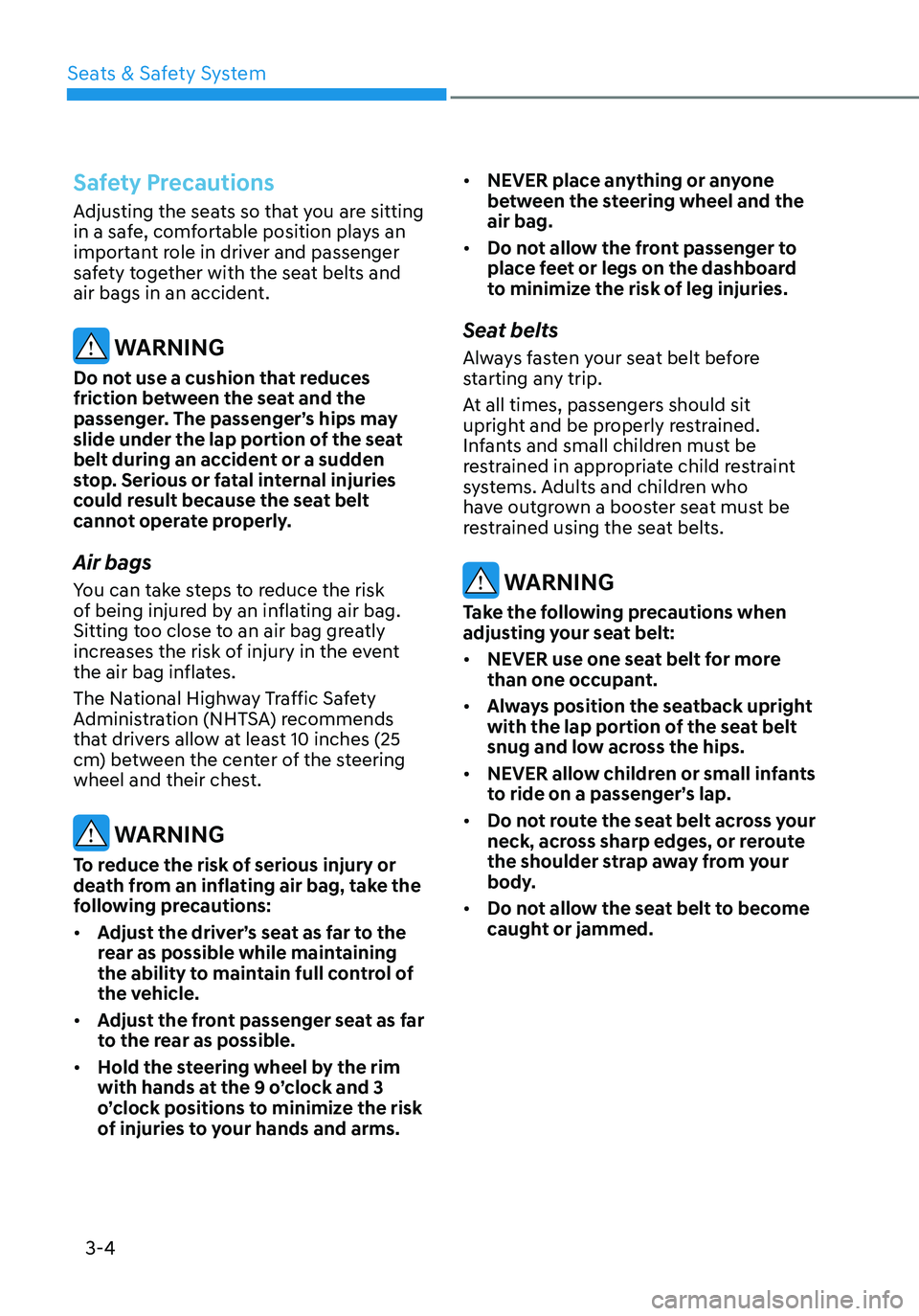
3-4
Safety Precautions
Adjusting the seats so that you are sitting
in a safe, comfortable position plays an
important role in driver and passenger
safety together with the seat belts and
air bags in an accident.
WARNING
Do not use a cushion that reduces
friction between the seat and the
passenger. The passenger’s hips may
slide under the lap portion of the seat
belt during an accident or a sudden
stop. Serious or fatal internal injuries
could result because the seat belt
cannot operate properly.
Air bags
You can take steps to reduce the risk
of being injured by an inflating air bag.
Sitting too close to an air bag greatly
increases the risk of injury in the event
the air bag inflates.
The National Highway Traffic Safety
Administration (NHTSA) recommends
that drivers allow at least 10 inches (25
cm) between the center of the steering
wheel and their chest.
WARNING
To reduce the risk of serious injury or
death from an inflating air bag, take the
following precautions:
• Adjust the driver’s seat as far to the
rear as possible while maintaining
the ability to maintain full control of
the vehicle.
• Adjust the front passenger seat as far
to the rear as possible.
• Hold the steering wheel by the rim
with hands at the 9 o’clock and 3
o’clock positions to minimize the risk
of injuries to your hands and arms. •
NEVER place anything or anyone
between the steering wheel and the
air bag.
• Do not allow the front passenger to
place feet or legs on the dashboard
to minimize the risk of leg injuries.
Seat belts
Always fasten your seat belt before
starting any trip.
At all times, passengers should sit
upright and be properly restrained.
Infants and small children must be
restrained in appropriate child restraint
systems. Adults and children who
have outgrown a booster seat must be
restrained using the seat belts.
WARNING
Take the following precautions when
adjusting your seat belt:
• NEVER use one seat belt for more
than one occupant.
• Always position the seatback upright
with the lap portion of the seat belt
snug and low across the hips.
• NEVER allow children or small infants
to ride on a passenger’s lap.
• Do not route the seat belt across your
neck, across sharp edges, or reroute
the shoulder strap away from your
body.
• Do not allow the seat belt to become
caught or jammed.
Seats & Safety System
Page 50 of 555
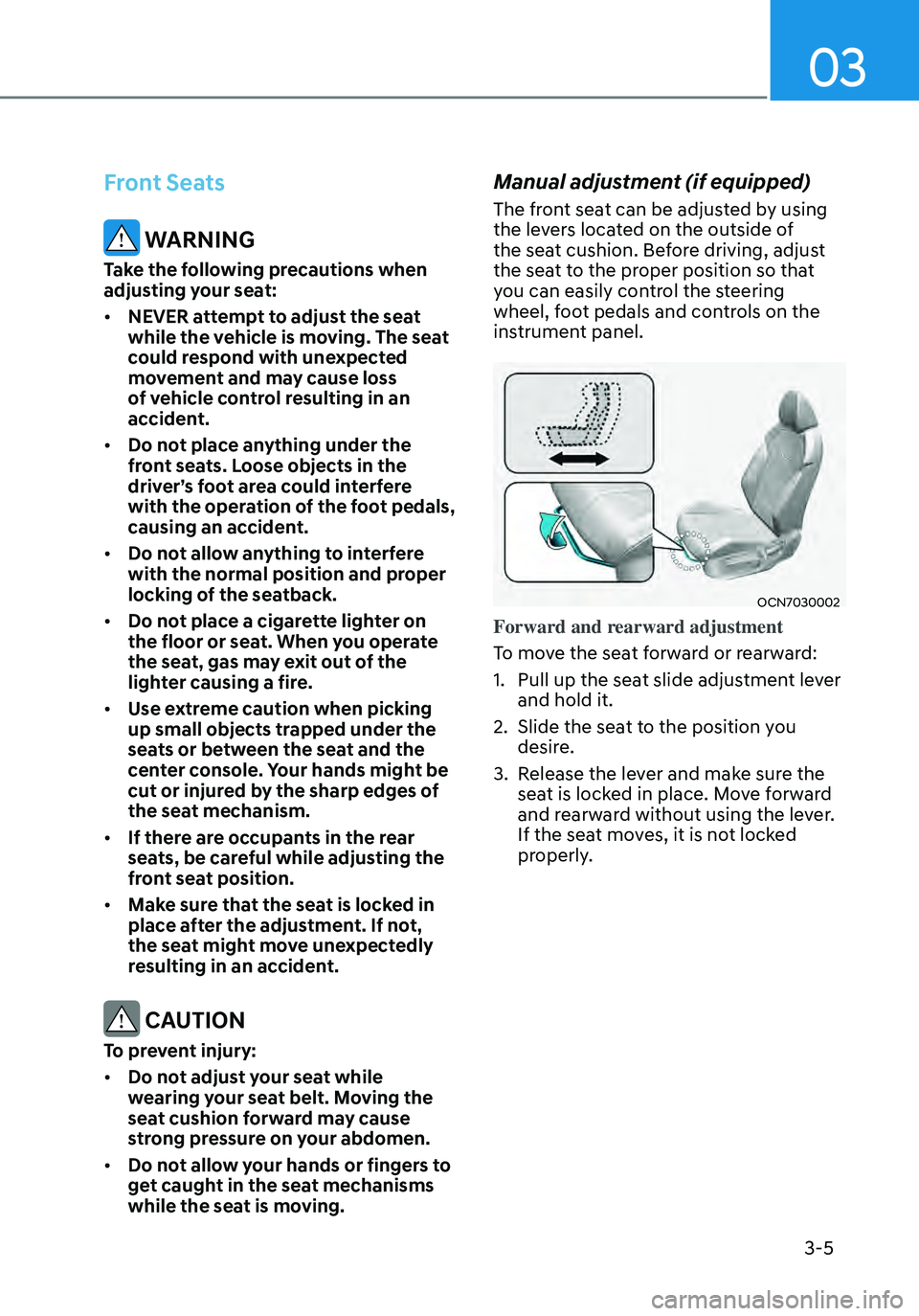
03
3-5
Front Seats
WARNING
Take the following precautions when
adjusting your seat:
• NEVER attempt to adjust the seat
while the vehicle is moving. The seat
could respond with unexpected
movement and may cause loss
of vehicle control resulting in an
accident.
• Do not place anything under the
front seats. Loose objects in the
driver’s foot area could interfere
with the operation of the foot pedals,
causing an accident.
• Do not allow anything to interfere
with the normal position and proper
locking of the seatback.
• Do not place a cigarette lighter on
the floor or seat. When you operate
the seat, gas may exit out of the
lighter causing a fire.
• Use extreme caution when picking
up small objects trapped under the
seats or between the seat and the
center console. Your hands might be
cut or injured by the sharp edges of
the seat mechanism.
• If there are occupants in the rear
seats, be careful while adjusting the
front seat position.
• Make sure that the seat is locked in
place after the adjustment. If not,
the seat might move unexpectedly
resulting in an accident.
CAUTION
To prevent injury:
• Do not adjust your seat while
wearing your seat belt. Moving the
seat cushion forward may cause
strong pressure on your abdomen.
• Do not allow your hands or fingers to
get caught in the seat mechanisms
while the seat is moving.
Manual adjustment (if equipped)
The front seat can be adjusted by using
the levers located on the outside of
the seat cushion. Before driving, adjust
the seat to the proper position so that
you can easily control the steering
wheel, foot pedals and controls on the
instrument panel.
OCN7030002
Forward and rearward adjustment
To move the seat forward or rearward:
1. Pull up the seat slide adjustment lever
and hold it.
2. Slide the seat to the position you
desire.
3. Release the lever and make sure the
seat is locked in place. Move forward
and rearward without using the lever.
If the seat moves, it is not locked
properly.